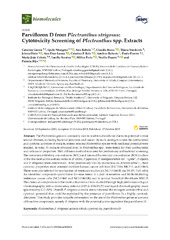Приказ основних података о документу
Parvifloron D from Plectranthusstrigosus: Cytotoxicity Screening of Plectranthus spp. Extracts.
| dc.creator | Garcia, Catarina | |
| dc.creator | Ntungwe, Epole | |
| dc.creator | Rebelo, Ana | |
| dc.creator | Bessa, Cláudia | |
| dc.creator | Stanković, Tijana | |
| dc.creator | Dinić, Jelena | |
| dc.creator | Díaz-Lanza, Ana | |
| dc.creator | P Reis, Catarina | |
| dc.creator | Roberto, Amílcar | |
| dc.creator | Pereira, Paula | |
| dc.creator | Cebola, Maria-João | |
| dc.creator | Saraiva, Lucília | |
| dc.creator | Pešić, Milica | |
| dc.creator | Duarte, Noélia | |
| dc.creator | Rijo, Patrícia | |
| dc.date.accessioned | 2019-11-01T08:51:23Z | |
| dc.date.available | 2019-11-01T08:51:23Z | |
| dc.date.issued | 2019 | |
| dc.identifier.uri | https://www.mdpi.com/2218-273X/9/10/616 | |
| dc.identifier.uri | https://radar.ibiss.bg.ac.rs/handle/123456789/3492 | |
| dc.description.abstract | The Plectranthus genus is commonly used in traditional medicine due to its potential to treat several illnesses, including bacterial infections and cancer. As such, aiming to screen the antibacterial and cytotoxic activities of extracts, sixteen selected Plectranthus species with medicinal potential were studied. In total, 31 extracts obtained from 16 Plectranthus spp. were tested for their antibacterial and anticancer properties. Well diffusion method was used for preliminary antibacterial screening. The minimum inhibitory concentration (MIC) and minimal bactericidal concentration (MBC) values of the five most active acetonic extracts (P. aliciae, P. japonicus, P. madagascariensis var. "Lynne", P. stylesii, and P. strigosus) were determined. After preliminary toxicity evaluation on Artemia salina L., their cytotoxic properties were assessed on three human cancer cell lines (HCT116, MCF-7, and H460). These were also selected for mechanism of resistance studies (on NCI-H460/R and DLD1-TxR cells). An identified compound-parvifloron D-was tested in a pair of sensitive and MDR-Multidrug resistance cancer cells (NCI-H460 and NCI-H460/R) and in normal bronchial fibroblasts MRC-5. The chemical composition of the most active extract was studied through high performance liquid chromatography with a diode array detector (HPLC-DAD/UV) and liquid chromatography-mass spectrometry (LC-MS). Overall, P. strigosus acetonic extract showed the strongest antimicrobial and cytotoxic potential that could be explained by the presence of parvifloron D, a highly cytotoxic diterpene. This study provides valuable information on the use of the Plectranthus genus as a source of bioactive compounds, namely P. strigosus with the potential active ingredient the parvifloron D. | en |
| dc.relation | Fundação para a Ciência e Tecnologia (FCT) grant (UID/DTP/04567/2016; UID/QUI/50006/2019; UID/DTP/04567/2019) | |
| dc.rights | openAccess | |
| dc.rights.uri | https://creativecommons.org/licenses/by/4.0/ | |
| dc.source | Biomolecules | |
| dc.subject | P. strigosus | |
| dc.subject | Plectranthus | |
| dc.subject | Antimicrobial | |
| dc.subject | Cytotoxicity | |
| dc.subject | Parvifloron D | |
| dc.title | Parvifloron D from Plectranthusstrigosus: Cytotoxicity Screening of Plectranthus spp. Extracts. | en |
| dc.type | article | en |
| dc.rights.license | BY | |
| dcterms.abstract | Цебола, Мариа-Јоãо; Гарциа, Цатарина; Динић, Јелена; Сараива, Луцíлиа; Ријо, Патрíциа; Нтунгwе, Еполе; Пешић, Милица; Дуарте, Ноéлиа; Станковић, Тијана; Ребело, Aна; Бесса, Цлáудиа; Дíаз-Ланза, Aна; П Реис, Цатарина; Роберто, Aмíлцар; Переира, Паула; | |
| dc.rights.holder | © 2019 by the authors. Licensee MDPI, Basel, Switzerland. | |
| dc.citation.issue | 10 | |
| dc.citation.volume | 9 | |
| dc.identifier.doi | 10.3390/biom9100616 | |
| dc.identifier.pmid | 31627339 | |
| dc.identifier.scopus | 2-s2.0-85073599817 | |
| dc.identifier.wos | 000497726800108 | |
| dc.citation.apa | Garcia, C., Ntungwe, E., Rebelo, A., Bessa, C., Stankovic, T., Dinic, J., et al. (2019). Parvifloron D from Plectranthusstrigosus: Cytotoxicity Screening of Plectranthus spp. Extracts. Biomolecules, 9(10), 616. | |
| dc.citation.vancouver | Garcia C, Ntungwe E, Rebelo A, Bessa C, Stankovic T, Dinic J, Díaz-Lanza A, P Reis C, Roberto A, Pereira P, Cebola M-J, Saraiva L, Pesic M, Duarte N, Rijo P. Parvifloron D from Plectranthusstrigosus: Cytotoxicity Screening of Plectranthus spp. Extracts. Biomolecules. 2019;9(10):616. | |
| dc.citation.spage | 616 | |
| dc.type.version | publishedVersion | |
| dc.identifier.fulltext | https://radar.ibiss.bg.ac.rs/bitstream/id/5481/Biomolecules_2019_9_10_616.pdf | |
| dc.citation.rank | M21 |

